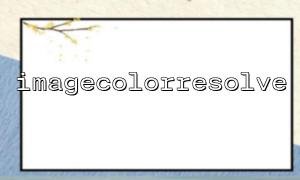In PHP, the imagecolorresolve() function is often used to process the color of an image. Its function is to find the colors in the image palette based on the RGB value and return the corresponding color index. While this function works well in small-scale applications, performance can become a bottleneck when dealing with large quantities of color judgments, especially when it comes to image processing or batch image conversion.
This article will discuss how to optimize the performance problems when using imagecolorresolve() in PHP for a large number of color judgments, and propose some practical optimization methods.
The function of the imagecolorresolve() function is to find out whether the specified color exists in the image palette. If the color already exists, it returns the corresponding color index; if the color does not exist, it adds it to the palette and returns the new index.
$color = imagecolorresolve($image, $red, $green, $blue);
Here, $image is the image resource, and $red , $green , and $blue are the RGB values of the color. imagecolorresolve() traverses the palette to find the color, a process that can affect performance, especially when there are a large number of different colors that need to be processed in the image.
When using imagecolorresolve() , if the image's palette is very large (for example, containing thousands of colors), each call to imagecolorresolve() requires iterating through the entire palette to find the color. This can significantly reduce performance when processing large or complex images.
When judging a large number of colors, PHP requires multiple color matching, which usually manifests as increased response delay, slow processing speed, and even excessive memory usage.
One optimization method is to store the resolved colors in a hash table so that every time the same color is encountered, you can get the index directly from the hash table without looking for the palette every time.
$colorCache = [];
function getColorIndex($image, $r, $g, $b) {
global $colorCache;
$key = "$r,$g,$b"; // Create a unique identifier for color
if (isset($colorCache[$key])) {
return $colorCache[$key]; // If the color already exists,Return directly
}
// If the color does not exist,use imagecolorresolve() Find and cache
$index = imagecolorresolve($image, $r, $g, $b);
$colorCache[$key] = $index;
return $index;
}
In this way, repeated color judgments will be cached, reducing the time of each search.
If your image is using a fixed number of colors (such as the color palette is already preset), you can directly match the color with its corresponding color value through the index array to avoid calling imagecolorresolve() for searching.
$palette = [
[255, 0, 0], // red
[0, 255, 0], // green
[0, 0, 255], // blue
// More colors...
];
function getColorIndexFromPalette($r, $g, $b, $palette) {
foreach ($palette as $index => $color) {
if ($color[0] === $r && $color[1] === $g && $color[2] === $b) {
return $index;
}
}
return -1; // If not found,return -1
}
In this method, a fixed color palette array is used to make judgments, which avoids dynamic color searches.
If you need to process a large number of images, you can consider performing color processing in batches to reduce the number of color judgments per call. Through batch processing, the time overhead is reduced every time imagecolorresolve() is called.
$batchSize = 100; // Number of colors per batch
$colors = getColorsFromImage($image);
$processedColors = [];
foreach (array_chunk($colors, $batchSize) as $batch) {
foreach ($batch as $color) {
$index = getColorIndex($image, $color['r'], $color['g'], $color['b']);
$processedColors[] = $index;
}
}
Doing so effectively reduces memory consumption and optimizes performance through batch processing.
In addition to the above optimization methods, there are some other tips to further optimize image processing performance:
Indexing images with palette : If the image itself is using an indexed image (i.e. the color has been predefined in the palette), the call to imagecolorresolve() is more efficient. Make sure to use indexed images whenever possible.
Reduce the number of colors of an image : In some cases, reducing the number of colors of an image (for example by color quantization) can significantly increase image processing speed, especially if the color of the image does not need to be too rich.
Optimize image size : The higher the resolution of the image, the more complex the judgment of color will be. Optimizing image size or using low-resolution images for processing can effectively reduce the processing burden.
In PHP, the imagecolorresolve() function may cause performance bottlenecks when making large quantities of color judgments. Performance can be significantly improved by using hash table cache, optimizing color judgment methods, and batch processing. In addition, using appropriate image formats and reducing the number of colors of the image is also a very effective optimization method. Knowing these optimization tips allows you to use PHP more efficiently when working with large numbers of images.















